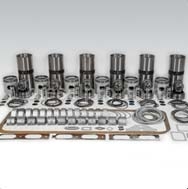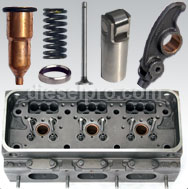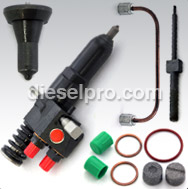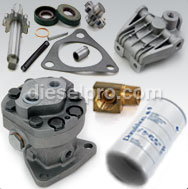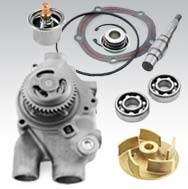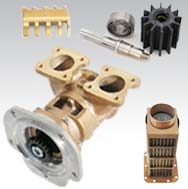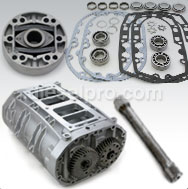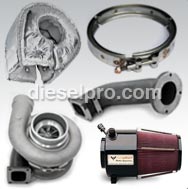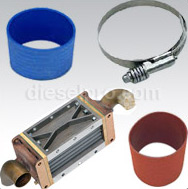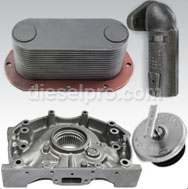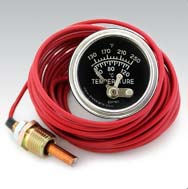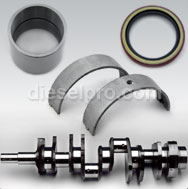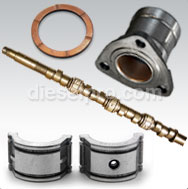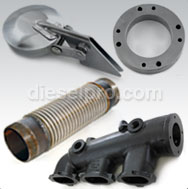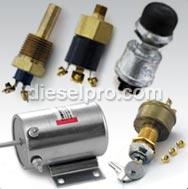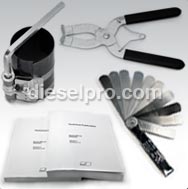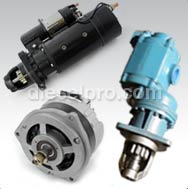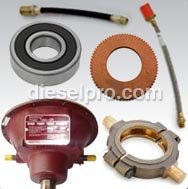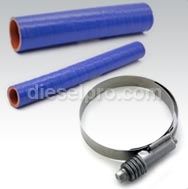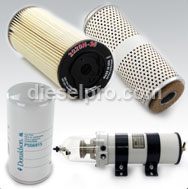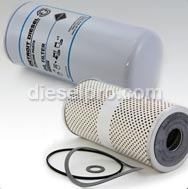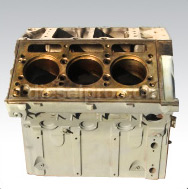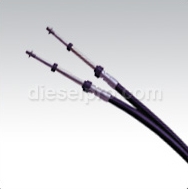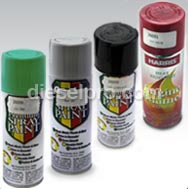The Detroit Diesel 6V71 Turbo engine is the turbocharged version of the legendary V6 configuration in the 71 Series. Combining the compact footprint of a 6-cylinder V-type engine with forced induction, the 6V71 Turbo delivers significantly more horsepower and torque than its naturally aspirated counterpart, making it the go-to choice for marine vessels, heavy-duty industrial equipment, and high-output generator sets. Renowned for its rugged design, simplicity, and modular components, the 6V71 Turbo uses a mechanically governed fuel system and a non-electronic turbocharger to increase engine breathing, improve combustion efficiency, and boost output—without sacrificing reliability. Its forced induction setup makes it ideal for operators needing extra power from the same 426 cubic inch displacement. At Diesel Pro Power, we carry a full line of aftermarket parts for the Detroit 6V71 Turbo engine—built to OEM-match or better. Whether you’re looking to rebuild, replace a turbo, or upgrade from naturally aspirated, our inventory includes overhaul kits, turbochargers, injectors, gasket sets, and more—all backed by expert support and fast global shipping. Engine Series: Detroit Diesel 71 Series Model: 6V71 Turbocharged Configuration: V6 (60° bank angle) Cycle: 2-Stroke Diesel Aspiration: Turbocharged, non-intercooled (factory configuration) Valvetrain: 4 valves per cylinder standard on turbo models (2 intake, 2 exhaust) Fuel Injection System: Mechanical unit injectors (pressure-timed) Firing Order: 1-4-5-2-3-6 Governor Type: Mechanical (variable or limiting speed) Compression Ratio: ~16.5:1 Bore: 4.25 inches (108 mm) Stroke: 5.00 inches (127 mm) Total Displacement: 426 cubic inches (6.99 liters) Despite the unchanged displacement from the non-turbo variant, the addition of a turbo allows significantly more air and fuel to be burned per cycle, increasing horsepower by up to 35%. Injector sizing, turbo specs, and governor settings determine power output: Injector Size Approx. Horsepower @ RPM N65 ~250 HP @ 2,100 RPM N70 ~265 HP @ 2,100 RPM N75 ~280 HP @ 2,100 RPM N80 ~300+ HP @ 2,100 RPM Marine RPM Range: Typically 2,100 RPM Industrial RPM Range: Often governed at 1,800 RPM Turbo Type: Fixed-geometry, exhaust-driven Boost Pressure: Typically 8–15 PSI under full load Mounting: Top-mounted exhaust manifold Intercooling: Not standard; optional in retrofitted systems Wastegate: Not common in original design Exhaust Manifold Material: Cast iron, high-heat rated Oil Feed: Turbocharger is pressure-lubricated and cooled by engine oil Diesel Pro Power offers replacement turbochargers, gaskets, studs, and oil lines—all tailored to 6V71 Turbo specs. Oil Capacity (with filters): ~9 gallons (34.1 liters) Cooling Capacity: ~6.5 gallons (24.6 liters) Oil Pressure (Operating): 40 – 60 PSI Normal Operating Temp: 170°F – 195°F Maximum Coolant Temp: 200°F Because the turbo increases heat load, proper cooling system function is even more important. Marine engines should use heavy-duty raw water or heat exchanger systems for thermal stability. Length: ~49 inches (124 cm) Width: ~41 inches (104 cm) Height: ~48 inches (122 cm) Dry Weight: ~2,250 – 2,300 lbs (1,020–1,043 kg), depending on turbo configuration Despite the turbo hardware, the engine retains a relatively compact profile—making it popular in vessels and equipment where space is at a premium but power demands are high. Compared to the non-turbo version, the turbocharged 6V71 offers 40–80 more horsepower and increased torque without changing the engine block or footprint. With forced induction, the engine achieves a more complete air-fuel burn—improving power-per-gallon and reducing soot output. Turbocharging improves performance at altitude, in hot climates, or under constant heavy load, making it ideal for global operations. Despite its boosted performance, the engine remains fully mechanical, with no sensors or ECUs required for operation, diagnostics, or repair. This engine is especially well-suited for commercial and performance marine operations requiring compact power and long duty cycles. Tugboats and Push Boats: Used in smaller tugs and pusher vessels requiring mid-range torque for maneuvering and towing. Fishing Vessels: Common in crabbers, shrimpers, and trawlers that benefit from added torque and cruise speed. Utility Vessels: Workboats and support boats operating cranes, hydraulic pumps, and winches. Transport and Cargo Vessels: Used in coastal transport and ferries requiring mid-range power with tight engine room constraints. Trawlers and Classic Yachts: Retrofitted into older vessels needing a power upgrade without overhauling the entire engine compartment. Liveaboard Vessels: Favorable for long-term cruising and reduced engine strain at travel RPMs. Restored Pilot Boats and Patrol Craft: Retains original Detroit sound and durability with added performance. The 6V71 Turbo's high torque and reliability make it a go-to solution for industrial operators needing continuous power. Generator Sets (80–125 kW): Prime or standby power in off-grid facilities, mining operations, and oil fields. Large Water Pumps: Found in flood control systems, irrigation infrastructure, and firefighting units. Construction Equipment: Used in pile drivers, hydraulic cranes, and mobile material handling rigs. Drilling Support Systems: Drives air compressors, pump skids, or rotary control units on drilling platforms. Marine Detroit Diesel 6V71 Component Maintenance Life The Legacy of the Detroit Diesel Marine 6V71 Engine & Its Use Today Detroit Diesel 6V71 Marine Engine Specifications (Turbo & Non-Turbo) Overview of the Detroit Diesel V71 Series Engines (6V71, 8V71, 12V71, 16V71) General Service Guidelines for Detroit Diesel V71 Series Engines (6V71, 8V71, 12V71, 16V71) Cylinder Block for Detroit Diesel V71 Series Engines (6V71, 8V71, 12V71, 16V71) Cylinder Head for Detroit Diesel V71 Series Engines (6V71, 8V71, 12V71, 16V71) Common Maintenance and Repair Needs for Detroit Diesel V71 Cylinder Heads (6V71, 8V71, 12V71, 16V71) Fuel and Air Systems for Detroit Diesel 6V71, 8V71, 12V71, and 16V71 Engines Injectors Maintenance for Detroit Diesel V71 Engines (6V71, 8V71, 12V71, 16V71) Governor Maintenance for Detroit Diesel V71 Engines (6V71, 8V71, 12V71, 16V71) Blowers Maintenance for Detroit Diesel V71 Engines (6V71, 8V71, 12V71, 16V71) Air Filters Maintenance for Detroit Diesel V71 Engines (6V71, 8V71, 12V71, 16V71) Fuel Leaks Troubleshooting for Detroit Diesel V71 Engines (6V71, 8V71, 12V71, 16V71) Air Intake Restrictions for Detroit Diesel V71 Engines (6V71, 8V71, 12V71, 16V71) Injector Malfunction Troubleshooting for Detroit Diesel V71 Engines (6V71, 8V71, 12V71, 16V71) Lubrication and Cooling Systems for Detroit Diesel 6V71, 8V71, 12V71, and 16V71 Engines Electrical and Exhaust Systems for Detroit Diesel 6V71, 8V71, 12V71, and 16V71 Engines Troubleshooting and Preventive Maintenance for Detroit Diesel 6V71, 8V71, 12V71, and 16V71 Engines Specifications and Torque Tables for Detroit Diesel 6V71, 8V71, 12V71, and 16V71 Engines Safety Considerations for Detroit Diesel 6V71, 8V71, 12V71, and 16V71 Engines Lubrication System: Comprehensive Guide For Detroit Diesel V71 Engines (6V71, 8V71, 12V71, 16V71) Oil Pumps for Detroit Diesel V71 Engines (6V71, 8V71, 12V71, 16V71) Oil Pressure Regulation For Detroit Diesel V71 Engines (6V71, 8V71, 12V71, 16V71) Oil Filters for Detroit Diesel V71 Engines (6V71, 8V71, 12V71, 16V71) Cooling System: Comprehensive Guide For Detroit Diesel V71 Engines (6V71, 8V71, 12V71, 16V71) Types of Cooling Systems for Detroit Diesel V71 Engines (6V71, 8V71, 12V71, 16V71) Key Components of the Cooling System for Detroit Diesel V71 Engines (6V71, 8V71, 12V71, 16V71) Raw Water Pump Specifics for Detroit Diesel V71 Marine Engines (6V71, 8V71, 12V71, 16V71) Importance of Cooling System Maintenance for Detroit Diesel V71 Engines (6V71, 8V71, 12V71, 16V71) Detailed Torque and Specifications For Detroit Diesel V71 Engines (6V71, 8V71, 12V71, 16V71) Step-by-Step Maintenance Procedures For Detroit Diesel V71 Engines (6V71, 8V71, 12V71, 16V71) Oil Pump Removal and Reassembly for Detroit Diesel V71 Engines (6V71, 8V71, 12V71, 16V71) Draining and Refilling the Cooling System For Detroit Diesel V71 Engines (6V71, 8V71, 12V71, 16V71) Troubleshooting Guide For Detroit Diesel V71 Engines (6V71, 8V71, 12V71, 16V71) Complete Parts Catalog for Detroit Diesel V71 Engines (6V71, 8V71, 12V71, 16V71) Comprehensive FAQ for Detroit Diesel V-71 Series Manual (6V71, 8V71, 12V71, 16V71)
Parts for Detroit Diesel 6V71 Turbo
-
Select Parts Category
 Loading...
Loading... Detroit Diesel 6V71 Turbo Engine Specifications & Applications
Introduction to the Detroit Diesel 6V71 Turbocharged Engine
Engine Configuration and Core Specifications
Bore, Stroke, and Displacement
Horsepower Output and Injector Sizing
Torque Output: 600–700 lb-ft depending on configuration
Turbocharger Specifications
Oil and Cooling System Capacities
Physical Dimensions and Weight
Advantages of the Detroit 6V71 Turbocharged Engine
Significant Power Increase
Improved Combustion Efficiency
Consistent Power in Extreme Conditions
Field-Serviceable Simplicity
Marine Applications of the Detroit Diesel 6V71 Turbo
Commercial Marine Use
Recreational and Restoration Marine Use
Industrial and Generator Applications
Additional Resources
Detroit Diesel 6V71, 8V71, 12V71, 16V71 Engine Tune Up



 Free US Calls: 1-888-433-4735
Free US Calls: 1-888-433-4735 International: 305-545-5588
International: 305-545-5588





